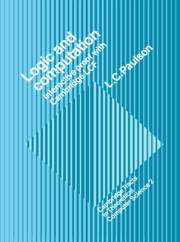6 - Theory Structure
Published online by Cambridge University Press: 17 September 2009
Summary
A large proof should be organized as a collection of theories. An LCF theory has a signature: its type constructors, constants, infixes, predicates. It may have parent theories, inheriting all their symbols and axioms. This rich environment may be extended by new axioms. Theorems may be proved and recorded in the theory.
Existing theories may become the parents of a new theory if their signatures are disjoint. Names of types, constants, infixes, and predicates cannot be hidden or renamed to avoid clashes. Each theory has separate name spaces for its axioms and theorems. An axiom is designated by the pair (theory name, axiom name), a theorem by (theory name, theorem name).
Theories do not have a tree structure: sharing always occurs. In Figure 6.1, the theory T has parents T1 and T2. They both have T4 as a parent. Both the theories T3 and T4 have T5 as a parent; both T4 and T5 have PPλ as a parent. Symbols declared in a common ancestor are shared. If the symbol + is declared in T4 then it is visible in both T1 and T2 and does not cause a clash between the two theories. But if it were declared in both T2 and T3 then T1 and T2 would clash during the construction of T.
Every theory is ultimately descended from PPλ. A theory is the child of its parents.
- Type
- Chapter
- Information
- Logic and ComputationInteractive Proof with Cambridge LCF, pp. 163 - 180Publisher: Cambridge University PressPrint publication year: 1987



